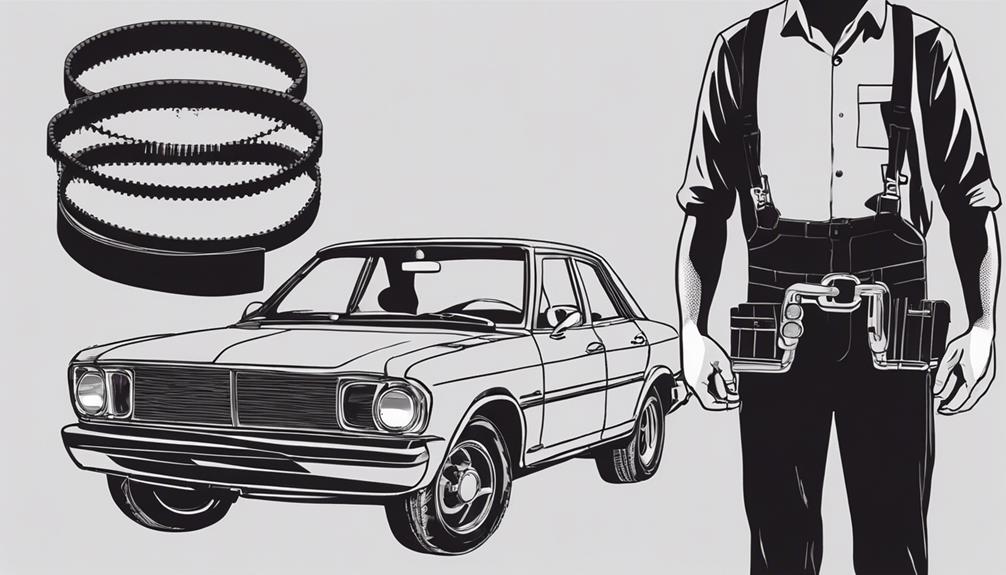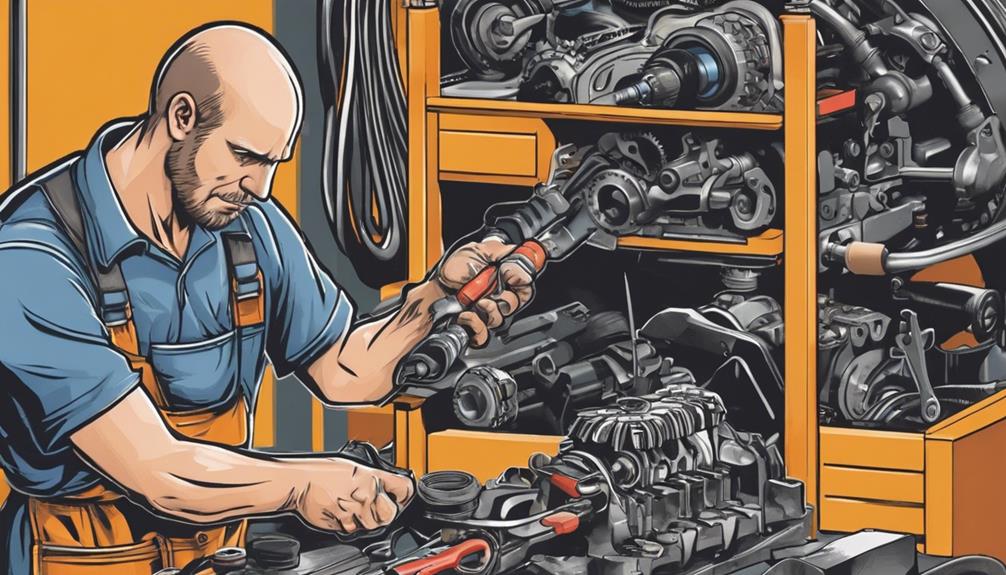Expert Tips for Timing Belt Replacement Timing
When it comes to the intricate dance of engine components, the timing belt is the conductor ensuring harmony. Expert advice on timing belt replacement timing is like a well-tuned melody – precise and essential.
But what if there's more than just mileage to consider? How can you ensure your engine's heartbeat stays steady and strong?
Let's explore the nuanced world of timing belt replacement timing and uncover the secrets to keeping your engine in sync.
Key Takeaways
- Follow manufacturer's recommended intervals for timely timing belt replacements.
- Look out for signs of wear like engine misfires and unusual noises.
- Consider cost factors like vehicle type, labor rates, and quality of parts.
- Opt for professional replacement for accuracy, warranty coverage, and prevention of engine damage.
Importance of Timing Belt Replacement
Ensuring timely replacement of your timing belt is critical to maintaining the precise synchronization of your engine's vital components, such as water pumps and injection pumps. The timing belt lifespan is influenced by factors like material quality and driving conditions. Regular timing belt maintenance is key to preventing unexpected failures that could lead to severe engine damage. The timing belt, made of rubber with high-tensile fibers, plays a crucial role in synchronizing the crankshaft and camshafts, ensuring optimal engine function.
Following the manufacturer's recommended replacement intervals is vital due to the lack of clear warning signs before belt failure. Mileage intervals for timing belt replacement differ among vehicle makes and models, underscoring the importance of timely replacement to avert potential engine issues. If in doubt about the timing belt replacement timing, seek advice from professionals to uphold your engine's performance and longevity. Remember, proactive maintenance is the key to liberating your engine from avoidable damage.
Signs of Timing Belt Wear
When inspecting for signs of timing belt wear, look out for indications such as engine misfires, rough idling, or difficulty starting the vehicle. To ensure your timing belt is in good condition, pay attention to the following warning signs:
- Engine Misfires: If your engine is misfiring, it could be a sign of timing belt wear affecting the synchronization of engine components.
- Rough Idling: A rough or uneven idle could indicate that the timing belt is worn and not functioning properly.
- Difficulty Starting: Struggling to start your vehicle may signal timing belt issues, preventing the engine from turning over smoothly.
- Unusual Noises: Listen for unusual sounds like squealing or ticking coming from the engine, which could indicate timing belt wear.
Regular visual inspections and staying alert to these maintenance tips can help you catch timing belt wear early, preventing unexpected breakdowns.
Timing Belt Replacement Frequency

To maintain optimal engine performance, adhere to the recommended replacement frequency of timing belts every 60,000 to 90,000 miles for preventive maintenance. Following these mileage recommendations is crucial to prevent engine damage and ensure the smooth operation of your vehicle. Regular timing belt replacements are essential preventive measures that can save you from costly repairs down the line. It is important to follow the manufacturer's guidelines on replacement intervals to keep your engine running efficiently.
| Timing Belt Replacement Guidelines | |
|---|---|
| Mileage Recommendations | 60,000 – 90,000 miles |
| Preventive Maintenance | Regular replacements |
| Engine Damage Prevention | Avoid costly repairs |
| Manufacturer's Recommendations | Follow guidelines |
| Interference Engines | Potential damage prevention |
Cost Considerations for Timing Belt Replacement
Considering the vehicle make, model, and labor rates, the cost of timing belt replacement can vary significantly. Here are some cost considerations for timing belt replacement:
- Vehicle Specific Costs: Different vehicles have varying timing belt replacement costs. High-performance or luxury vehicles often require specialized components, leading to higher overall expenses.
- Labor Rates: Labor rates play a significant role in the total cost. Shops with higher hourly rates will generally charge more for timing belt replacement.
- Cost Saving Options: Opting for aftermarket parts or timing belt kits can help reduce expenses. However, ensure compatibility and quality to avoid future issues.
- Professional Installation: While DIY kits may seem budget-friendly, professional installation ensures correct fitment and may come with warranty coverage, providing peace of mind.
DIY Vs. Professional Timing Belt Replacement

For optimal timing belt replacement results, assess your proficiency level and vehicle's complexity before deciding between DIY and professional services.
DIY timing belt replacement offers the benefit of potential cost savings on labor. However, it requires specific tools and expertise to ensure proper installation and alignment. The risk with a DIY approach is that mistakes can lead to engine damage if not done correctly.
On the other hand, professional timing belt replacement services come with the benefits of warranty coverage and expertise in handling complex engine components. Professional technicians have access to specialized equipment and training for efficient and accurate timing belt replacement. The downside may be higher labor costs compared to a DIY approach.
Choosing between the two methods depends on your individual skill level, time availability, and comfort with complex engine work. Consider the pros and cons carefully before making a decision to ensure the best outcome for your vehicle.
Frequently Asked Questions
What Are the Tips for Timing Belt?
To maintain your timing belt, inspect it regularly based on mileage. Replacement every 60,000 to 90,000 miles is crucial to prevent engine damage. Follow manufacturer guidelines for optimal performance and avoid costly repairs.
What Else Should You Do When Replacing Timing Belt?
When replacing the timing belt, remember to address tensioner adjustment, water pump replacement, camshaft alignment, and belt tension calibration. These steps are crucial for optimal engine performance and longevity. Trust the process and ensure precision.
How Do You Break in a New Timing Belt?
To break in a new timing belt, maintain proper belt tension and follow engine break-in procedures. Avoid harsh acceleration and high RPMs for the first 500 miles, drive at varying speeds, and listen for unusual noises.
How Many Hours of Labor Does It Take to Change a Timing Belt?
To change a timing belt, labor estimates typically run around 1.7 hours, varying by vehicle. This involves precise steps for alignment and tension, often requiring special tools. Professional mechanics are recommended for efficient and accurate timing belt changes.
Conclusion
In conclusion, when it comes to timing belt replacement, failure to adhere to manufacturer recommendations can result in catastrophic engine failure. Ignoring signs of wear and neglecting proper maintenance can lead to costly repairs and potential safety hazards on the road.
Remember, staying on top of timing belt replacement isn't just a suggestion, it's a critical necessity for the health and longevity of your engine. Don't risk it – prioritize timing belt maintenance for optimal performance.







